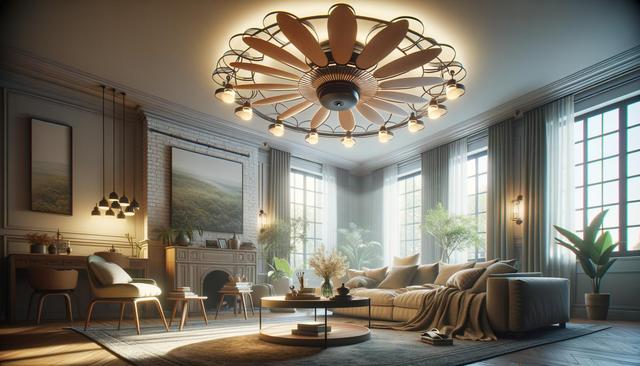The Shift Away from Ceiling Fans
For decades, ceiling fans have been a go-to solution for home cooling. However, as technology advances and energy efficiency becomes more important, many homeowners are rethinking this traditional fixture. Ceiling fans can circulate air, but they often fall short in providing consistent, room-wide cooling—especially during hotter months. They also require regular maintenance, can be noisy, and may not complement modern interior aesthetics.
In contrast, new cooling devices are offering more versatile and efficient ways to stay comfortable indoors. These modern alternatives are not only redefining how we cool our homes but are also helping reduce energy costs and carbon footprints. With their sleek designs and smart features, it’s no surprise that more people are choosing to ditch ceiling fans in favor of these innovative systems.
What Makes These Devices Stand Out?
Unlike traditional fans, modern cooling devices leverage advanced technology to optimize airflow, temperature control, and energy usage. Many of these systems integrate seamlessly with smart home ecosystems, allowing users to monitor and adjust settings remotely or through voice control. This level of convenience is a major factor in their growing popularity.
Here are some standout features that make these devices more appealing than ceiling fans:
- Quiet operation with minimal disruption
- Improved energy efficiency compared to older models
- Compact, space-saving designs
- Ability to control humidity and air quality
- Customizable settings for greater comfort
These devices are engineered to deliver targeted cooling, meaning they can adapt to the needs of different rooms or times of day. This not only improves comfort but also helps reduce unnecessary energy consumption.
Energy Efficiency and Environmental Benefits
One of the key reasons homeowners are embracing modern cooling solutions is their superior energy performance. Traditional ceiling fans, while relatively low on power consumption, do not actually lower room temperature. They merely create a breeze that can make it feel cooler. In contrast, newer cooling technologies are designed to regulate actual indoor temperatures efficiently.
Many of these systems are equipped with energy-saving modes, programmable timers, and eco-friendly refrigerants. As a result, they contribute to lower electricity bills and reduced environmental impact. For households aiming to adopt sustainable practices, switching to energy-efficient cooling devices is a practical step forward.
Additional benefits include:
- Reduced reliance on central air conditioning systems
- Decreased greenhouse gas emissions
- Smarter usage patterns through automation
These environmental advantages are especially appealing to homeowners who are conscious of their ecological footprint and want to make more responsible choices.
Design and Aesthetic Versatility
Another compelling reason to replace ceiling fans with modern cooling devices is their design flexibility. Ceiling fans have a fixed look and location, which can limit interior design options. In contrast, newer devices come in a wide range of styles and configurations—from wall-mounted units to portable models and even discreet ceiling-integrated systems.
Modern cooling solutions can complement various interior styles, whether minimalist, industrial, or contemporary. Their unobtrusive appearance allows them to blend seamlessly into living spaces without drawing attention or disrupting the room’s visual flow.
Homeowners can also benefit from:
- Customizable color and finish options
- Smaller footprint compared to traditional fans
- Flexible installation options for different room layouts
This level of design adaptability is especially valuable in smaller spaces or homes with open floor plans, where maintaining a cohesive aesthetic is important.
The Growing Popularity and Market Trends
The demand for modern cooling solutions has seen a significant rise in recent years. As more people become aware of the limitations of traditional ceiling fans, the shift toward innovative alternatives continues to accelerate. Market research indicates that consumer interest in energy-efficient and smart home-compatible cooling devices is expected to grow steadily over the next decade.
Several factors are driving this trend:
- Increased awareness of energy conservation
- Rising temperatures and more frequent heatwaves
- Preference for smart home convenience
- Greater availability of affordable models
Homeowners are also influenced by peer recommendations and online reviews, which often highlight the reliability and performance of these modern cooling options. Whether renovating an existing home or designing a new one, many are choosing to integrate these solutions from the start, avoiding the need for ceiling fans altogether.
Conclusion: Embrace the Future of Home Cooling
As the popularity of modern cooling solutions continues to grow, it becomes increasingly clear that ceiling fans are no longer the only—or the most efficient—option for home comfort. With advancements in technology, energy efficiency, and design, these innovative devices offer a compelling alternative that aligns with contemporary lifestyles and environmental goals.
For homeowners looking to upgrade their living spaces, exploring these new devices can lead to better comfort, lower energy bills, and a more modern aesthetic. By moving beyond traditional ceiling fans, you can embrace a smarter, more sustainable way to stay cool and comfortable all year round.


